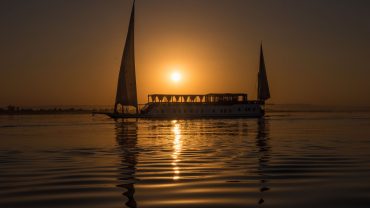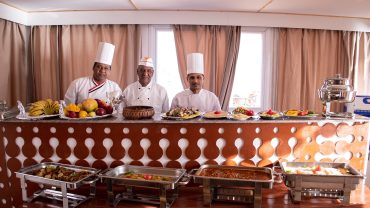Sailing down the Nile in Egypt has always been on my ‘to do’ list. When I finally got the chance to tick it off that list, it easily lived up to my expectations. Egypt is struggling for tourists right now and I was happy to work with Djed Egypt Travel and get on board one of their beautiful Dahabiya Boats to sail up the Nile from Esna to Aswan. These graceful boats are built by local craftsmen in Esna following the design of the original 19th-century vessels. They have delightful cabins (with air-con) with antique furniture, en suite bathrooms, and a view to die for.
These boats only take up to a dozen passengers and so it is a very personal experience. It’s nice to have some fellow passengers to chat with up on deck while watching the banks of the Nile glide by. It looks like scenes from the story of Moses. Palm trees, small villages, donkeys, boys, boys on donkeys, water buffalo, and always the cool green, river, glittering in the sunlight. Dahabiya means ‘the golden one’ in Arabic. We were traveling on the Orient, a wooden vessel with two large sails, one at either end.
Our ship’s crew were a real asset. Our captain Mr Nubu was said to be the oldest man on the Nile at 78, still sailing and cracking jokes with the crew. The chef conjured up three delicious meals a day with super fresh local ingredients in his galley kitchen on board. We even had tea at 4pm on deck with scrumptious homemade cakes. The food was lots of salads, grains and fresh vegetables – tomatoes and cucumbers taste so much nicer when grown in the Egyptian heat. Homemade bread was served with some chicken, duck or fish from the river in the evenings. The beef stew was particularly tasty. Mohmaed Bashek the chef also lead impromptu drumming, singing and dancing in the evening after dinner on deck – a man of many talents. It was all a lot of fun.
The smaller Dahabiya can moor in places where the large cruise ships can’t go, so we got to stop and see lots of interesting but less accessible local sites along the route. We stopped at the ancient ruins of Al Kap and saw the tombs of the nobles. The hieroglyphics inside these tombs explained much more about the everyday lives of people than the religious scripts within the more famous tombs in The Valley of the Kings. The images showed parties where they drank wine and sniffed Lotus flowers. Others showed hunting, agriculture, and farm animals. We took a caleche (horse-drawn carriage) to the temple of Edfu which was even more impressive as we pretty much had the site to ourselves for quite a while. We were pursued through local villages by gangs of curious children and visited the sandstone quarry where huge blocks were hewn to be sent up the Nile (or down) to construct the incomparable temples of Egypt. These giant blocks were cut from the rock bed with only primitive tools and drills with incredible precision and strength. Tombs set into the rock overlooking the river were nearby with the most amazing view. A bit lost on the dead really! It is safe to swim in the Nile now, as long as you are careful about the currents. It wasn’t always this way. Until relatively recently, the aggressive Nile crocodile was a real threat to people living along the banks of this enormous river. The ancient Egyptians revered the power of this fearsome creature and created Sobek the crocodile god in their honor. At the temple of Kom Ombo (City of Gold), there is a large selection of mummified crocodiles, as one specimen was chosen to be a God from time to time and preserved upon its expiry. Today, the dam has contained these predators, and so it was safe for us to swim in the cold, clear refreshing waters of the Nile, which was lovely.
I loved my trip to the Nile Dahabiya boats. The beautiful scenery gliding by, the friendly people, and the ancient sites are a pretty unique combination. It’s pretty safe around the Luxor area and if you decide to go there now, believe me, you will be very well looked after. There are bargains to be had and it is a fantastic time to visit the sites without the hordes of tourists that were there a decade ago. I now have a passable knowledge of hieroglyphics and great respect for the ancient Egyptians who lived there three thousand years ago. I also have a renewed affection for the people who are trying to make a living there today.





Comment (0)